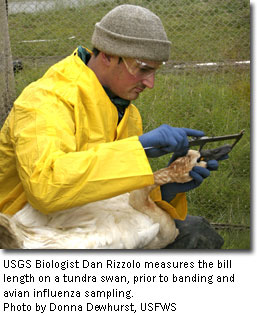Tundra Swan
(Cygnus columbianus)
Description & Range:
There are two populations of tundra swans recognized in North America:
eastern and western. The Eastern population winters on the Atlantic Coast in
the Chesapeake Bay of Maryland and North Carolina. These swans later travel
to the Arctic tundra areas from the Seward Peninsula of Alaska, east to
Hudson Bay and Baffin Island to nest. In contrast, the Western population
winters on the Pacific Slope, mainly in California.
The plumage of adult Tundra swans is completely white, though their heads and
necks are often stained a rusty color from iron-rich foods encountered in marsh
soils during feeding. Their legs, feet and beak are black and they have a
distinctive yellow mark close to the eyes. Both sexes are identical in
appearance, but males typically are larger. The Tundra swan is smaller than the
uncommon trumpeter swan, but it is difficult to separate them in the field.
Habitat:
Tundra swans breeds near shallow pools, lakes and slow-flowing rivers with
emergent vegetation and pondweeds connected to moist, low-lying sedge-grass or
moss-lichen Arctic tundra. Swans rarely nests in shrub tundra, and generally
avoids forested areas. When migrating, they frequent shallow ponds, lakes,
reservoirs, riverine marshes, shallow saline lagoons and sheltered coastal bays
and estuaries. During the winter, Tundra Swans inhabit brackish and freshwater
marshes, rivers, lakes, ponds and shallow tidal estuarine areas with adjacent
agricultural fields. Calfpasture Cove at Eastern Neck National Wildlife Refuge
near Rock Hall and the waste water treatment ponds near Hurlock are favorite
wintering sites in Maryland.
Diet:
Tundra swans feed on aquatic plants found in shallow water. To get their food
from underwater, the swans tip their bodies and extend their long neck and head
into the water. They barely ever dive all the way in. They primarily feed on
widgeon grass, sago and clasping leaf pondweeds and wild celery, but also
utilize waste grain (corn and soybeans) and winter wheat shoots. During the
winter, Tundra swans may also eat invertebrates such as mollusks (e.g., clams),
amphipods and polycheate worms on tidal mudflats prior to migration.
 Reproduction:
Reproduction:
Tundra swans breed throughout the Arctic and sub-Arctic tundra from Bristol
Bay, Alaska, north along the Bering Sea coast, the Arctic Ocean east to Baffin
Island, and south to the northwest coast of Quebec. Their nests are usually
built on points or hummocks close to a tundra pond or lake, and those in
favorable locations often reuse the same area from year to year. On average,
females hatch three to five eggs and sit on them until they hatch, usually 32
days. Male tundra swans don’t help with incubation, but they stay close to the
nest and guard against any predators, such as foxes, wolves, bears, weasels and
golden eagles.
Sounds:
The Tundra swan's call is high-pitched and reminiscent of snow geese, while
the trumpeter swan's call is louder and has been compared to the sound of a
French horn.
Behavior:
Tundra swans begin leaving their winter habitat after the first spring thaw.
Tundra swans from Chesapeake Bay cross Pennsylvania to Lake Erie, from the first
week in March into early April and provide a striking spectacle when several
thousand make a stop near Long Point on Lake Erie.